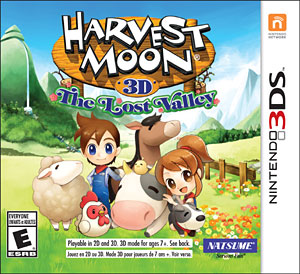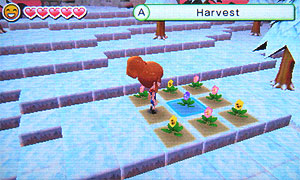
|
Release Dates: |
An unofficial guide covering Harvest Moon: The Lost Valley for Nintendo 3DS |

|
Harvest Moon: The Lost Valley is a Harvest Moon game from Natsume, Inc. Developed in conjuction with Tabot, the game designed with a chibi-style similar to Harvest Moon: Back to Nature and Harvest Moon: Friends of Mineral Town. In The Lost Valley, players can grow over 100 types of crops, raise farm animals, and interact with the local residents as the player develops the abandoned farm.

The Story of the Lost Valley
As the hero of the game, you heard stories of the beautiful Lost Valley and want to see it for yourself. When you arrive, you are caught in a mysterious blizzard. As you stomp and shiver through the unexpected snow, you hear a voice that encourages you to seek refuse in a nearby cabin. That night, you dream of a strange blue-haired lady who asks you to help her. In the morning, you are awaken by a little voice coming out of a pile of snow. As you free the trapped fellow, you learn about how the valley has been stuck in a forever Winter. Eventually, you'll be recruited to help resolve the problem and return the normal seasonal flow to the Lost Valley.
Game Features
In this version of the series, players will control the land of the Lost Valley. Soil can be built up to make hills or removed to create ponds and crevasses, allowing the player to completely control the topography of the valley. To explore some areas, players will have to build soil steps to reach higher spaces or build block bridges to cross rivers. Players can build 16 field squares upwards as well as dig 16 farm blocks downward.
The game also features a contextual tool system, where players do not have to equip a tool to use it. As long as the tool is in the hero's bag, the game will automatically use it when at the correct location. For example, stand on a crop and press the A Button to use your watering can, and then just move over to a tree and press the A Button again to chop it down with your axe. Then walk into the barn and press A to feed the cows, and A again to pet them. No need to swap tools or worry about accidentally hitting the livestock with your Hoe.
The player can choose to play as either a boy hero or a girl hero, with the main difference between the two is with the potential marriage candidates. Later in the game, the option to customize the character's clothing and hair style will be available. You can also customize the flooring, drapes, and wallpaper of the farm house. There are three marriage candidates per gender, and the marriage can produce a child.

There are over 100 types of crops that can be grown in the valley. The height and depth of the field space will affect the crops raised on these field spaces; a crop planted below ground level will produce something different than if planted at ground level, and the same can be true for the crop planted high up on a hill. There is also fertilizer you can apply to the crops to increase the produced crop's quality.
The livestock animal options have been simplified, allowing the player to raise cows, sheep, and chickens. Animals will have personality traits, up to 30 unique ones, which can be bred from animal to animal to maximize its traits. For example, some traits make animals happier in certain seasons, be less stressed, or raise friendship faster when brushed. A horse is also available to ride around the valley.
Other features include:
- Hire the Harvest Sprites to do farm work for you
- Complete requests from the area's residents
- Build barns, wells, windmills, and other objects, and decide their placement within the valley
- Go fishing in the streams, using different types of feed to entice fish bites
- Options to control the volume of the background music and game sound effects
- Post-release download content (DLC), both free and paid
- Mine for ores and gems, and have them processed into construction materials
- Participate in seasonal festivals
- Two save slots, and you can save anywhere and anytime
- 10-character name spacing
- ... and much more!
What is Story of Seasons!?
In past years, Natsume has used a Japanese publisher's game to localize as Harvest Moon. The Bokujou Monogatari series first came into play during the Super Nintendo years of the 1990s, which was then localized into English as Harvest Moon. Since then, the two companies, Marvelous (as it is currently known as) and Natsume, have been working together to release additional versions of the game series. Typically, Marvelous handles the release in Japan, Natsume gets the Japanese game and manages the English release in the Americas, and then Rising Star Games or Marvelous EU would get the English release and develop any additional languages for the European release.
A few years ago, Marvelous acquired XSeed Games via merger and have been using their subsidiary to localize the company's Japanese games such as the popular Rune Factory 4. Since big Marv has its own localization team, why not have them handle the English Bokujou Monogatari localization too? The big hiccup is that Marvelous doesn't own the trademark to Harvest Moon; that is exclusively a legal brand that was developed by Natsume's marketing and sales efforts. Marvelous won't be able to use the Harvest Moon trademark, so the company had rebranded the latest version of their Bokujou Monogatari game as Story of Seasons for English release.
Natsume has been handling the game series for the English-speaking fans since the beginning, and now that Marvelous has taken their Bokujou Monogatari localization internally, it frees up Natsume to develop their own farming simulation game using their existing Harvest Moon brand as well as knowledge of English gamer preferences.
Now we have two harmonizing farming games, each with their own unique features and characters, yet similar in gameplay. Hopefully both the new Story of Seasons series and the existing Harvest Moon series will be successful and enjoyed by all video game farming fanatics.
Harvest Moon: The Lost Valley is © Natsume, Inc. Story of Seasons is © Marvelous. This is a personal fan site and is not officially sponsored or employed by MAQL or Natsume. This guide is built off of personal gameplay experiences as well as feedback from other Harvest Moon players and fans. Web site design © 2014 fogu.com